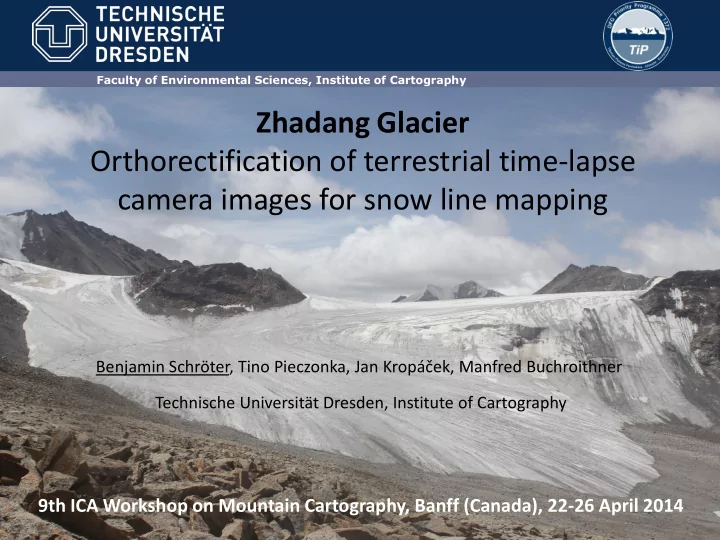

Faculty of Environmental Sciences, Institute of Cartography Zhadang Glacier Orthorectification of terrestrial time-lapse camera images for snow line mapping Benjamin Schröter , Tino Pieczonka, Jan Kropáček, Manfred Buchroithner Technische Universität Dresden, Institute of Cartography 9th ICA Workshop on Mountain Cartography, Banff (Canada), 22-26 April 2014
Faculty of Environmental Sciences, Institute of Cartography Outline 1. Motivation 2. Investigation area – Zhadang Glacier 3. Terrestrial time-lapse camera system 4. Orthorectification – method and workflow 5. Results 6. Conclusion/Outlook
Faculty of Environmental Sciences, Institute of Cartography Motivation 1. Glaciers are key indicators for the ongoing climate change 2. The covering snowpack considerably affects the glacier-ice surface temperature and thus the meltdown of the glaciers 3. The detailed investigation as well as the accurate delineation of the actual snow line – here defined as the fluctuating lower altitudinal boundary of the snow- covered area – are of high importance 4. Evaluation and validation of a glacier mass balance model developed at RWTH Aachen
Faculty of Environmental Sciences, Institute of Cartography Tibet
Faculty of Environmental Sciences, Institute of Cartography Framework within research projects: TiP and WET
Faculty of Environmental Sciences, Institute of Cartography Nam Co Zhadang Glacier Nyainqêntanglha Range Lhasa
Faculty of Environmental Sciences, Institute of Cartography Zhadang Glacier (5,515 – 6,090 m a.s.l., 2 km 2 ) Photo: T. Pieczonka (2009)
Terrestrial camera system, Zhadang Glacier Photo: T. Pieczonka (2009) Titel der Präsentation Folie Nr. 8 von XYZ
Faculty of Environmental Sciences, Institute of Cartography Map: E. Huintjes (2013)
Faculty of Environmental Sciences, Institute of Cartography Terrestrial camera system, Zhadang Glacier 2010/2011 picture series from 2010 picture series from 2011 2 cameras, each 6 pictures/day = 6,225 images between May 2010 and September 2012
Faculty of Environmental Sciences, Institute of Cartography Terrestrial camera system, Zhadang Glacier Cam1/Cam2 picture series 2011 from Cam 1 picture series 2011 from Cam 2 2 cameras, each 6 pictures/day = 6,225 images between May 2010 and September 2012
Faculty of Environmental Sciences, Institute of Cartography Problem: movement/shift of both cameras due to melting/refreezing or possibly earthquake
Faculty of Environmental Sciences, Institute of Cartography Orthorectification of the camera images with software RSG (Remote Sensing Software Graz) 1. Manual orthorectification (1 image/week/camera), detection of the image coordinates of the GCPs (change because of camera movement) 2. Renaming of all images (scheme cam1_20110716_14) 3. Interpolation of image coordinates of the GCPs and generation of a .cl (column- line) file for every image (same file name like corresponding image) 4. Selection of „good“ GCPs with lowest residuals (cam 1: 6 GCPs, cam 2: 5 GCPs) 5. Batch-processing (reference is SRTM – resampled to 1 m, image and interpolated image coordinates of the GCPs are connected by the file names)
Faculty of Environmental Sciences, Institute of Cartography 7 GCPs that can be identified in every picture (repeatedly measured in the field)
Faculty of Environmental Sciences, Institute of Cartography Orthorectified area of Zhadang Glacier ( Image distortion due to very gentle rise of the upper part of the glacier)
Faculty of Environmental Sciences, Institute of Cartography
Faculty of Environmental Sciences, Institute of Cartography Example of workflow image to ortho-image with snowline Camera 1: view towards south
Faculty of Environmental Sciences, Institute of Cartography Nadir view, northened
Faculty of Environmental Sciences, Institute of Cartography Snowline on nadir view
Faculty of Environmental Sciences, Institute of Cartography
Faculty of Environmental Sciences, Institute of Cartography
Faculty of Environmental Sciences, Institute of Cartography - A remarkable result is the proof of the existence of ablation due to heavy snow drift and sublimation on the glacier during the winter months (DJFM)
Faculty of Environmental Sciences, Institute of Cartography Image from February 6 2012 at 22:00
Faculty of Environmental Sciences, Institute of Cartography Conclusions/Outlook 1. Considerable variability and fluctuation of the snow lines 2. Proof of snow drift and sublimation 3. Automatization of the process 4. GLOF monitoring in Halji, Nepal
Faculty of Environmental Sciences, Institute of Cartography Pléiades DEM (2013), 1 m resolution Halji-Glacier Pléiades DEM (2013) to SRTM-3 (2000) N. Holzer (2013) N. Holzer (2013)
Faculty of Environmental Sciences, Institute of Cartography Morphometry of the lake basin First GLOF modeling results SFM N. Neckel (2014) DEM based on fusion of SFM and DGPS measurements B. Tyrna (2014)
Faculty of Environmental Sciences, Institute of Cartography Terrestrial Camera Automatic Weather Station Photos: B. Schröter (2014)
Thank you very much for your TU Dresden >> Faculty of Forest, Geo and Hydro Sciences >> Institute of Cartography Faculty of Environmental Sciences, Institute of Cartography attention! Nicolai Holzer: TU Dresden Thanks to: Eva Huintjes: RWTH Aachen Niklas Neckel: Eberhard Karls Universität Tübingen Further questions: benjamin.schroeter@tu-dresden.de
Recommend
More recommend